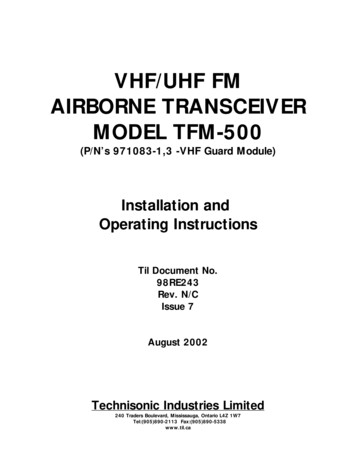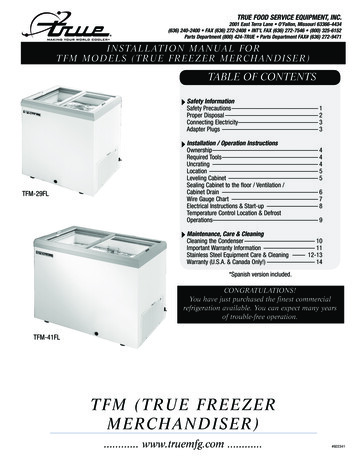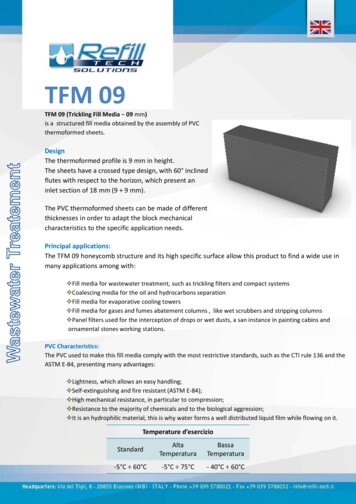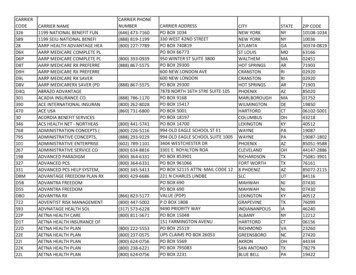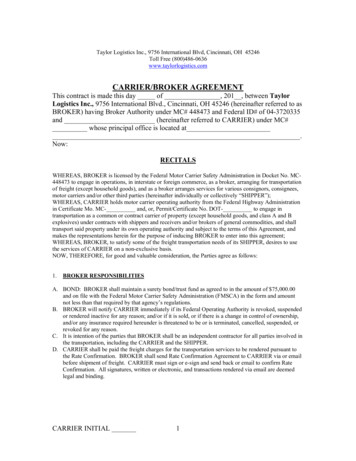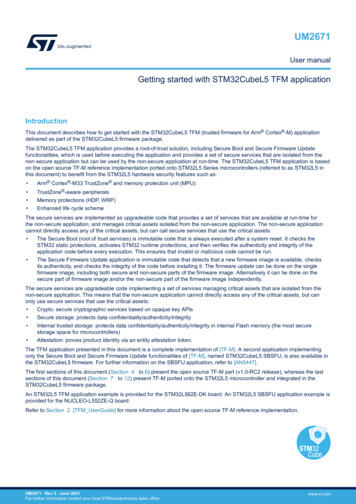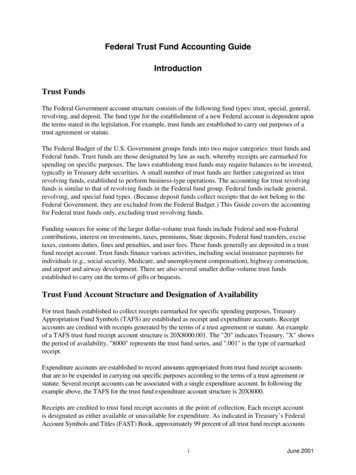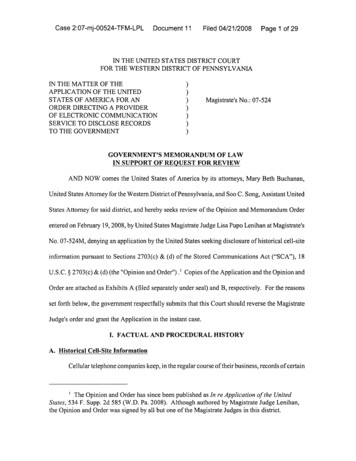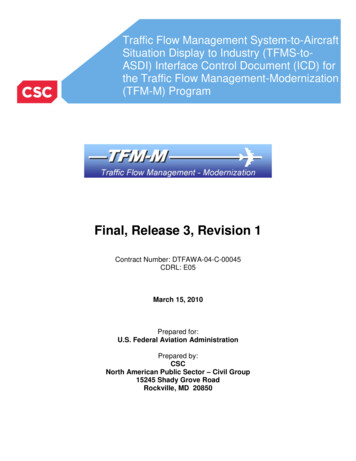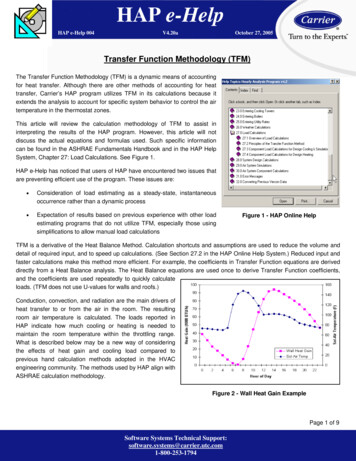
Transcription
HAP e-HelpHAP e-Help 004QB TIP 001V4.20aOctober 27, 2005Transfer Function Methodology (TFM)The Transfer Function Methodology (TFM) is a dynamic means of accountingfor heat transfer. Although there are other methods of accounting for heattransfer, Carrier’s HAP program utilizes TFM in its calculations because itextends the analysis to account for specific system behavior to control the airtemperature in the thermostat zones.This article will review the calculation methodology of TFM to assist ininterpreting the results of the HAP program. However, this article will notdiscuss the actual equations and formulas used. Such specific informationcan be found in the ASHRAE Fundamentals Handbook and in the HAP HelpSystem, Chapter 27: Load Calculations. See Figure 1.HAP e-Help has noticed that users of HAP have encountered two issues thatare preventing efficient use of the program. These issues are: Consideration of load estimating as a steady-state, instantaneousoccurrence rather than a dynamic process Expectation of results based on previous experience with other loadestimating programs that do not utilize TFM, especially those usingsimplifications to allow manual load calculationsFigure 1 - HAP Online HelpTFM is a derivative of the Heat Balance Method. Calculation shortcuts and assumptions are used to reduce the volume anddetail of required input, and to speed up calculations. (See Section 27.2 in the HAP Online Help System.) Reduced input andfaster calculations make this method more efficient. For example, the coefficients in Transfer Function equations are deriveddirectly from a Heat Balance analysis. The Heat Balance equations are used once to derive Transfer Function coefficients,and the coefficients are used repeatedly to quickly calculateloads. (TFM does not use U-values for walls and roofs.)Conduction, convection, and radiation are the main drivers ofheat transfer to or from the air in the room. The resultingroom air temperature is calculated. The loads reported inHAP indicate how much cooling or heating is needed tomaintain the room temperature within the throttling range.What is described below may be a new way of consideringthe effects of heat gain and cooling load compared toprevious hand calculation methods adopted in the HVACengineering community. The methods used by HAP align withASHRAE calculation methodology.Figure 2 - Wall Heat Gain ExamplePage 1 of 9Software Systems Technical 1794
HAP e-HelpHAP e-Help 004V4.20aQB TIP 001October 27, 2005Transfer Function Methodology (TFM)The dynamics of heat gain over time are best described graphically. Because an east-facing wall (See Figure 2) is used in theexample, the sol-air temperature curve shows the effects of large morning heat gains due to solar radiation and smallerafternoon heat gains due to reduced sunshine but warmer outdoor air temperatures. The heat gain curve reveals the transientheat transfer processes involved. While the sol-air temperatures peak at 8 a.m., the interior wall heat gains for this mediumweight wall do not peak until 2 p.m. This reveals the time it takes for heat to be conducted through this specific type of wallconstruction.Radiation heat gains from sources such as solar, lights and even people take time to become a load. The radiant heat mustfirst heat up the building and contents and then be conducted and released over time to the room air by convectionprocesses. This causes a delay between the time a heat gain occurs and the time its full effects as a cooling load appear.Figure 3 shows the load and heat gainsfor lights turned on for six hours. Note thatthe loads are smaller than the heat gainswhile the lights are on. This is because alarge portion of the heat gain is thermalradiation.Also note that cooling loads continue afterlights are turned off and the heat gainscease. Again, this is due to the radiantheat and the heat storage effects. Whenthe lights are turned off, some radiatedheat from the previous six hours is stillstored in the room mass and continues tobe convected to room air over time.Figure 3 - Lighting Heat Gain ExamplePage 2 of 9Software Systems Technical 1794
HAP e-HelpHAP e-Help 004QB TIP 001V4.20aOctober 27, 2005Transfer Function Methodology (TFM)Figure 4 illustrates that the Transfer Function Method models the transient build-up and discharge of heat in a building.The convection process is governed by the temperaturedifference between the mass and the room air. Convectiondecreases as the room air temperature rises and increasesas the room air temperature decreases. Hand calculationmethods assume a constant room air temperature at allhours to simplify this complex process. However, controlsystems have a throttling range, varying the room airtemperature. Using night set up or not cooling duringunoccupied times may cause an increase in roomtemperature and a decrease in convection, effectivelystoring heat for release. Later, on system start up, theroom air temperature rapidly decreases and a connectiverush of heat can occur. This is sometimes referred to as apull down load. See Figure 5.Figure 4 - Peak Load Time LagThe TFM can calculate the effect of the changing room air temperature on the cooling and heating requirements. This is doneusing the Space Air Transfer functions referred to as Heat Extraction. This can be thought of as a thermostat and pulldownadjustment.Figure 5 - Peak Loads: 24 Hours versus 16 hoursPage 3 of 9Software Systems Technical 1794
HAP e-HelpHAP e-Help 004V4.20aQB TIP 001October 27, 2005Transfer Function Methodology (TFM)The transfer function with heat extraction is implemented in three steps and two stages in HAP.Stage OneStep One: The conduction equations are used to analyze the heat flow through walls and roofs.Step Two: The room transfer functions are used to analyze the radiative, convective and heat storage processes of allcomponents. Convective components are instantaneous and radiative components are stored and released over time.Stage TwoStep Three: The space air temperature transfer functions (heat extraction equations) are used to analyze the effects of thechanging room air temperature on convective heat flow from mass to room air that includes the behavior of the roomthermostat.In the Stage One, Steps One and Two are completed assuming a constant room air temperature 24 hours. The components,control zones, and the system are sized. These components comprise the Zone and Space Loads reported in HAP. SeeFigures 7, 8, 9, and 10.In the Stage Two, Step three calculations are done. The system is simulated using the sizing from the first stage to correctthe loads to what is needed to try to maintain set point. This is the “Zone Conditioning” reported in HAP (See Figures 7, 9, and10.To illustrate the results of this procedure, Figure 6shows load, heat extraction, and room temperatureprofiles for a scenario in which HVAC equipmentoperates for the period 8 a.m. to 10 p.m., and is offfor the remaining hours of the day. Figure 6 showsthe cooling load profile calculated using the roomtransfer function procedures and assuming aconstant room temperature. The actual roomtemperature profile shows that during the 8 a.m. to10 p.m. operating period; the equipment maintainsthe zone within the thermostat throttling range of 72 F to 76 F. During the off hours, the zonetemperature floats above the throttling range.During this period, heat is accumulated in thebuilding mass. When the equipment operatingperiod begins at 8 a.m., this accumulated heat isremoved in addition to the hourly cooling loads. Thisresults in a pulldown component of the load.Figure 6 - Load, Heat Extraction, and Room Temperature ProfilesPage 4 of 9Software Systems Technical 1794
HAP e-HelpHAP e-Help 004QB TIP 001V4.20aOctober 27, 2005Transfer Function Methodology (TFM)The HAP report “Air System Design Load Summary” (Figure 7) shows the results of the two stages of the calculationprocedure. The Total Zones Loads are the results of Stage One. The “Zone Conditioning” and “Total Conditioning" results arefrom the Stage Two calculation.Figure 7 - Air System Design Load SummaryPage 5 of 9Software Systems Technical 1794
HAP e-HelpHAP e-Help 004QB TIP 001V4.20aOctober 27, 2005Transfer Function Methodology (TFM)The Zone DesignLoadSummaryand Space DesignLoadSummaryreports (Figure 8)show the detail oftheStageOneresults.Figure 8 - Space Design Load Summary and Zone Design Load Summary ReportsPage 6 of 9Software Systems Technical 1794
HAP e-HelpHAP e-Help 004QB TIP 001V4.20aOctober 27, 2005Transfer Function Methodology (TFM)The Hourly Zone Loads report (Figure 9) shows the hourly results of the Stage One and Stage Two calculations as well asthe varying hourly zone air temperature achieved.Figure 9 - Hourly Zone Load ReportPage 7 of 9Software Systems Technical 1794
HAP e-HelpHAP e-Help 004QB TIP 001V4.20aOctober 27, 2005Transfer Function Methodology (TFM)Graphing the column of numbers from the two stages can be done from the Hourly Zone Design Day Loads (see Figure 10).The magnitude of the pull down load can be seen at 6 am. The extra amount of “conditioning” represents the true demand forcooling needed for running 11 hours instead of 24 can easily be seen.Figure 10 - Hourly Design and Day LoadsPage 8 of 9Software Systems Technical 1794
HAP e-HelpHAP e-Help 004V4.20aQB TIP 001October 27, 2005Transfer Function Methodology (TFM)As a review, when performing calculations to determine required airflow rates, supply terminal characteristics, and coilcapacities for HVAC systems, HAP uses the following general eight-step procedure:1. Compute sensible and latent loads for all zones served by the HVAC system.2. Sum zone loads to obtain sensible and latent loads for the HVAC system.3. Determine required zone airflow rates.4. Compute required sizes for terminal reheat coils as necessary.5. Determine required system airflow rates. This includes sizing all fans and outdoor ventilation airflow rates.6. Simulate HVAC system operation. Based on the required airflow rates determined in Steps 3 through 5. Operation ofthe HVAC system is mathematically simulated to produce profiles of loads on central cooling and heating coils.7. Identify peak coil loads. Cooling and heating coil load profiles from Step 6 are inspected to identify maximum loads.8. Report results.The results of these calculations can yield important benefits such as the ability to analyze the realistic transient heat transferthat occurs in all buildings. Loads can also be accurately computed for any heat gain sequence and wall or roof construction.Consequently, resulting loads are specific and customized for each application analyzed, accounting for local weatherconditions, building construction and operating schedules. The value of these benefits is obvious for HVAC design work.Further articles in this series of HAP e-Help will build upon this discussion and explore how the HAP software can assistsystem design rather than just load calculation.Page 9 of 9Software Systems Technical 1794
capacities for HVAC systems, HAP uses the following general eight-step procedure: 1. Compute sensible and latent loads for all zones served by the HVAC system. 2. Sum zone loads to obtain sensible and latent loads for the HVAC system. 3. Determine required zone airflow rates. 4. Compute required sizes for terminal reheat coils as necessary. 5.
